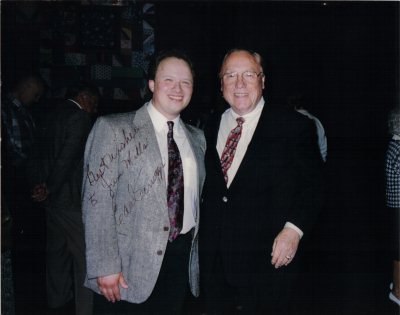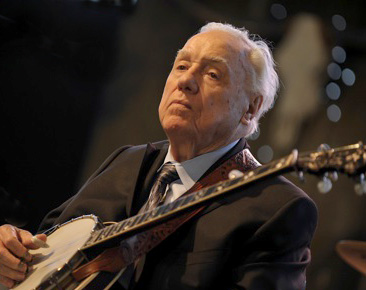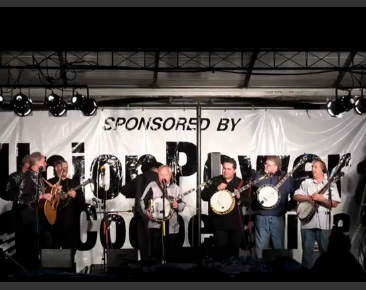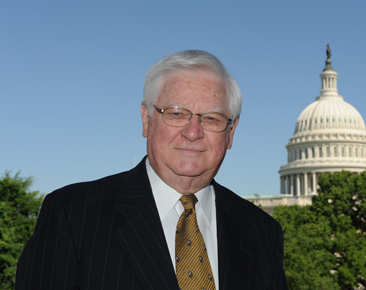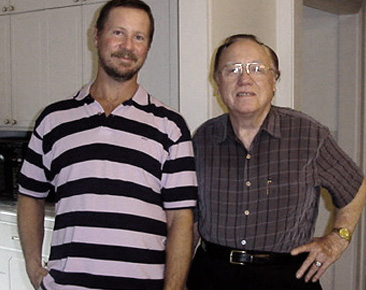
This commemoration of Earl Scruggs comes from Jack Hatfield, who has earned his living teaching Scruggs’ music for almost 40 years. His Scruggs Corner columns for Banjo Newsletter are collectors items, as they contained start-to-finish transcriptions from Scruggs recordings, including backup. Jack also operates the Smoky Mountain Banjo Academy, dedicated to passing on and preserving the playing of both three finger and clawhammer banjo. The 2012 event is scheduled for May 4-6, sponsored in part by Nechville.
Here, Jack seeks to provide a thumbnail description of what made Earl Scruggs’ playing so unique – from a technical standpoint – for the non-banjo playing fan.
 We lost a legend recently. It remains virtually undisputed: Earl Scruggs was both the architect and the Master of bluegrass banjo style. We can ponder what bluegrass would be like, or even there would even be a genus of music called bluegrass if Bill Monroe had stuck with Stringbean, or if Don Reno had not been called to serve in the military.
We lost a legend recently. It remains virtually undisputed: Earl Scruggs was both the architect and the Master of bluegrass banjo style. We can ponder what bluegrass would be like, or even there would even be a genus of music called bluegrass if Bill Monroe had stuck with Stringbean, or if Don Reno had not been called to serve in the military.
It was the addition of Earl Scruggs’ banjo style that crystallized the Monroe sound, providing the missing element Monroe was seeking that would make his band unique. Monroe didn’t know himself exactly what he was looking for, and even for a while after Earl joined the band he was still not sure it was the right component. However, when audiences at the Grand Ole Opry and radio audiences around the South responded wildly to Earl’s playing, he had to keep the young man, and so bluegrass was born.
Why did this particular style of banjo playing intrigue us like no other? Homo sapiens crave organization. The most basic way to organize sounds (or anything else) is with equal spacing. Like the ocean waves on the shore or our own heartbeat…equal spacing. This is what Earl brought to the banjo…equal note spacing. Though he did not invent the three-finger style, he took what others were doing and refined it so the notes were not only evenly spaced, but also extremely fast. Couple this with the loud, piercing, brilliant tone of a banjo and like it or not, it is as impossible to ignore as a machine gun.
The notes of the five-string banjo in a bluegrass ensemble are like the evenly spaced steel rods used to reinforce concrete. The bass and guitar in a bluegrass rhythm section are like the fence posts and the banjo notes are like the pickets. Without the pickets, the fence would not be a fence. In fact, if you have ever run a stick along a picket fence, you have created a crude model of bluegrass rhythm.
The equal note spacing speaks for itself, but how did Earl achieve the blinding speed? He did it by not repeating a digit on consecutive eighth notes, and by limiting the number of licks and finger sequences. Reduce Earl’s finger sequences to their most basic elements and there are only three: The Alternating Thumb sequence (T-I-T-M) the Forward sequence (T-I-M) and the Backward sequence (M-I-T). He combined these building blocks to create five or six patterns that would fit neatly within a four beat measure of common time.
Later the term “roll” was coined to describe these patterns. Earl’s rolls allowed an odd number of digits to fit into an even number of beats. Virtually everything Earl did employed these five or six rolls, cut and pasted in different combinations. Think of it – Earl recorded dozens of instrumentals, hundreds of solos on vocal numbers, thousands of verses of backup, all using only five or six finger sequences! The more something is rehearsed, the better it is performed. In using a limited number of right hand sequences, Earl practiced each millions of times. This is why he was able to hone his licks to such a high level of speed and precision.
The final piece of the puzzle: Earl played the melody. Those who do not play the banjo may not appreciate how difficult it is to maintain a continuous stream of eighth notes, while not repeating a digit, and still render a recognizable melody. However, the rolls Earl devised do exactly that. In addition to precise note spacing and high speed, they allow the stronger thumb to play most of the melody notes on the all-important first and fourth downbeats.
Ralph Stanley was more simplistic – he thought in terms of the more elemental three note forward roll. He attains excellent note spacing and speed because of the simplicity… however, his approach does not allow the thumb to play as many of the melody notes, and more melody notes are misplaced a half beat to accommodate the roll. Ralph often extended the forward roll across measure lines.
Earl also extended the forward roll across measure lines, but primarily in backup and when the melody notes were spaced far enough apart. Both of these musicians have the incredible drive, which can only be produced by an extended forward roll. Don Reno used more sequences than Earl. He rendered an accurate melody, even on complex pop and swing instrumentals, but because of his much more extensive “lickabulary,” the note spacing was not as precise. His entire approach was more sophisticated, so naturally he appealed to fewer listeners, those who had more refined musical tastes.
This comparison/contrast is not meant to detract from either of the other great bluegrass pioneers – their fans loved their music as much as Earl’s loved his, and there is room in the music world for these three approaches and infinitely more. This is merely to point out that Scruggs’s style created a proportion of note spacing, speed, and melody that appealed to a greater audience. This appeal was greatly magnified by Flatt & Scruggs’ contributions to the Beverly Hillbillies television show, and the movie Bonnie and Clyde.
However, to give credit where credit is due…Earl was the first. If he were not the first and the best, he would not have been chosen to do these sound tracks in the first place. He would not have been the only banjo player of his generation to perform at Carnegie Hall.
Did Earl analyze his approach and plan this out ahead of time? I think not. I believe when one is devoted to a musical instrument, their music eventually takes on their personality. Earl was a simple man. He was a man of few words, but those words were direct, sincere, and to the point. Progressive banjo players use more notes, more finger sequences, more complex chord voicings, and many of them have produced great music. However, less is more. The limited number and basic nature of Earl’s right hand sequences made possible a precision of timing and rate of speed that none of his peers could equal. Earl’s genius lay in his simplicity.
Rhythm is the most fundamental aspect of music. Precise timing is something even non-musicians can relate to. This is why, when Earl played the five-string banjo, he was not just communicating with other banjo players or other musicians. He was communicating on a deep psychological level with Everyman.
Earl: Exceptional Efficiency and Extreme Elegance.

